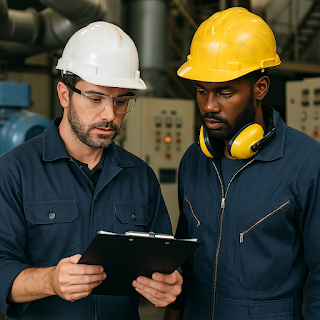Effective
supervision in maintenance management ensures that work is performed
efficiently, safely, and in compliance with established procedures. This involves
several key aspects, including clear job assignments, performance monitoring,
on-the-job training, emergency response preparedness, and continuous
improvement initiatives.
1.
Clear Job Assignments and Responsibilities
A
well-defined job assignment ensures that maintenance personnel understand their
tasks and expectations. This includes:
- Work
Orders & Task Allocation: Supervisors should
assign specific work orders, detailing the scope, deadlines, and resources
required.
- Roles
& Responsibilities: Each team member must
be aware of their responsibilities, whether it's preventive maintenance,
corrective repairs, or inspections.
- Job
Prioritization: Tasks should be categorized based on
urgency and impact on operations.
- Coordination
with Other Departments: Maintenance teams
must collaborate with operations, safety, and engineering teams to ensure
seamless work execution.
- Shift
Handover Procedures: A structured handover process
ensures that critical information is passed between shifts to maintain
continuity.
2.
Performance Monitoring and Reporting
Supervisors
need to track the progress and effectiveness of maintenance tasks to ensure
continuous improvement. This includes:
- Regular
Inspections: Supervisors should conduct periodic
checks to verify work quality and adherence to standards.
- Work
Progress Tracking: Utilize maintenance management
software or manual tracking systems to log completed tasks.
- KPI
Measurement: Monitor key performance indicators
(KPIs) such as Mean Time Between Failures (MTBF), Mean Time To Repair
(MTTR), and Equipment Uptime.
- Feedback
& Performance Reviews: Conduct evaluations
to identify skill gaps and areas for improvement.
- Incident
Reporting & Analysis: Document and analyze
maintenance-related incidents to prevent recurrence.
- Workforce
Productivity Assessment: Ensure that labor
utilization is optimized to prevent delays and inefficiencies.
- Use
of Digital Tools: Implement IoT sensors, AI-driven
analytics, and digital dashboards for real-time condition monitoring and
predictive maintenance.
3.
On-the-Job Training and Mentorship
Training
and mentorship programs ensure that maintenance staff develop the necessary
skills and knowledge to perform their duties effectively. Key aspects include:
- Hands-on
Training: New and junior employees should
receive practical, supervised training on equipment handling and
troubleshooting.
- Safety
Training: Regular sessions on hazard
identification, proper tool usage, and compliance with safety regulations.
- Knowledge
Transfer: Senior technicians and engineers
should mentor less-experienced workers to improve their problem-solving
skills.
- Cross-Training:
Encouraging multi-skilling among workers to enhance flexibility in
handling different maintenance tasks.
- Certification
& Licensing: Ensure that personnel handling
specialized equipment hold the required certifications.
4.
Emergency Response Preparedness
Maintenance
teams must be prepared to handle unexpected failures and emergency situations
effectively. Key measures include:
- Emergency
Procedures: Establish clear protocols for
equipment failure, fire hazards, and electrical faults.
- Rapid
Response Teams: Assign designated personnel for
emergency repairs and crisis management.
- Availability
of Spare Parts & Tools: Ensure that critical
spare parts and tools are readily available to minimize downtime.
- Simulation
Drills: Conduct regular emergency response
drills to test preparedness and refine response strategies.
- Backup
Power & Redundant Systems: Implement alternative
power sources and backup equipment to maintain operations during failures.
- Communication
& Coordination: Establish clear communication
channels between maintenance, operations, and safety teams during
emergencies.
- Common
Challenges & Solutions: Identify bottlenecks
in emergency response and implement corrective measures to improve
reaction time.
5.
Continuous Improvement Initiatives
To
enhance maintenance efficiency and reliability, continuous improvement programs
should be implemented. These include:
- Root
Cause Analysis (RCA): Identify underlying causes of
recurring failures and implement corrective actions.
- Predictive
Maintenance Strategies: Utilize condition
monitoring techniques such as vibration analysis, thermography, and oil
analysis.
- CMMS
Implementation: Use Computerized Maintenance
Management Systems (CMMS) to streamline work order management and asset
tracking.
- Lean
Maintenance Practices: Minimize waste and optimize
resources by adopting lean methodologies.
- Employee
Suggestion Programs: Encourage staff to contribute ideas
for improving maintenance processes.
- Benchmarking
& Industry Best Practices: Compare performance
metrics with industry standards to identify improvement areas.
- Regulatory
Compliance: Ensure adherence to industry
regulations, safety codes, and environmental standards to avoid penalties
and operational risks.
- Cost
Control & Budgeting: Monitor maintenance
costs, optimize resource allocation, and implement cost-saving strategies
without compromising quality.
- Case
Studies & Real-Life Examples: Analyze successful
maintenance programs from different industries to identify best practices
that can be adapted.
Conclusion
Effective
supervision in maintenance management is crucial for ensuring operational
efficiency, safety, and compliance with industry standards. By implementing
clear job assignments, performance monitoring, continuous training, emergency
preparedness, and continuous improvement initiatives, maintenance teams can
significantly improve their work execution and overall asset reliability. A
proactive approach to supervision will result in reduced downtime, cost
savings, and a safer working environment.
📌 If
you are interested in working in this field, you can find it 👉 here



